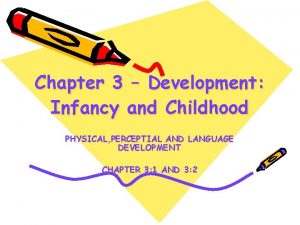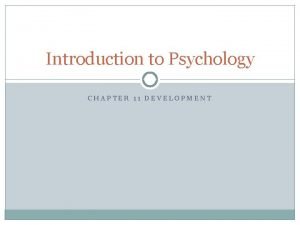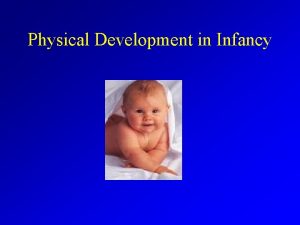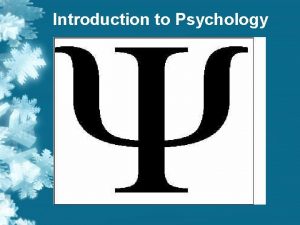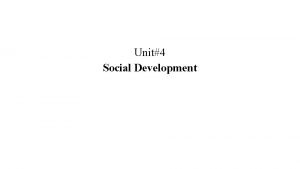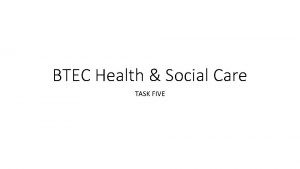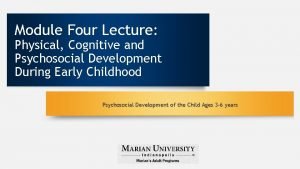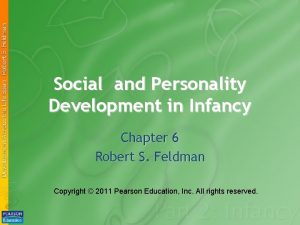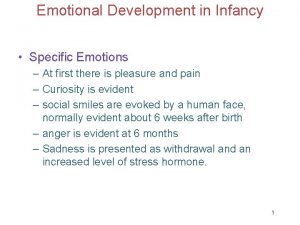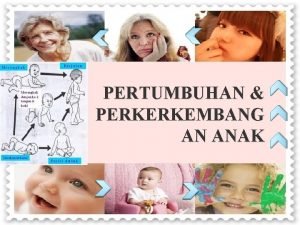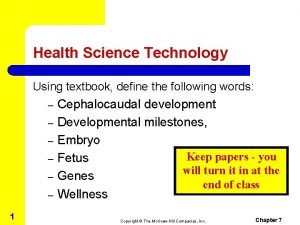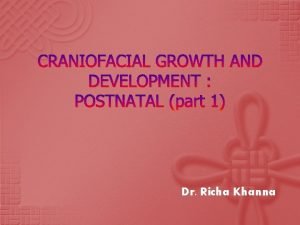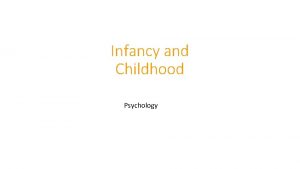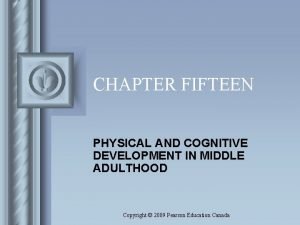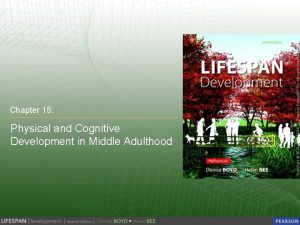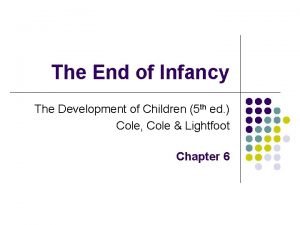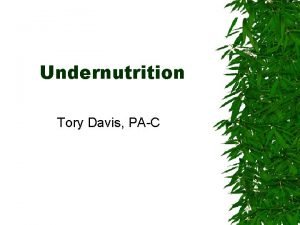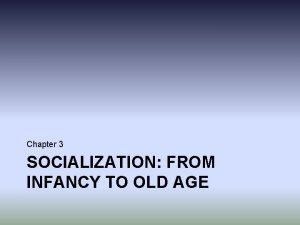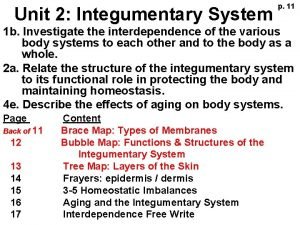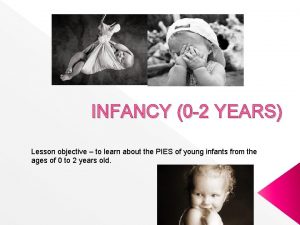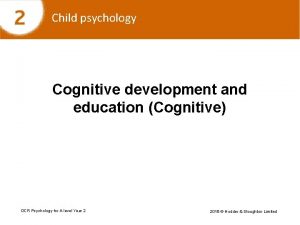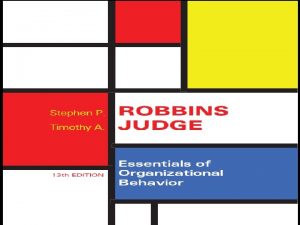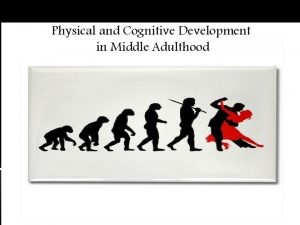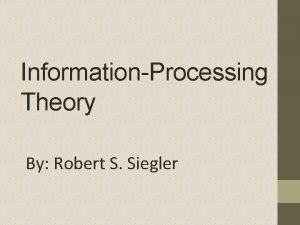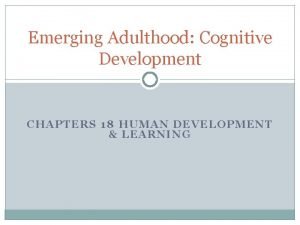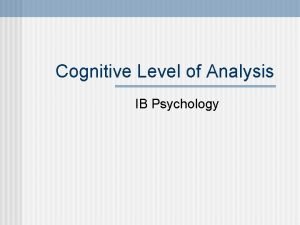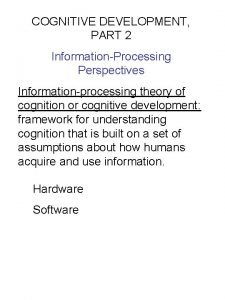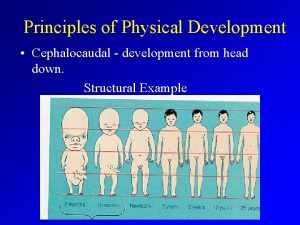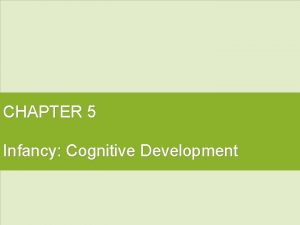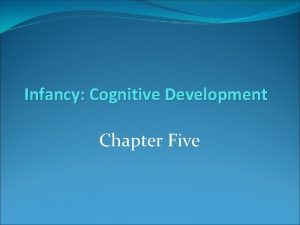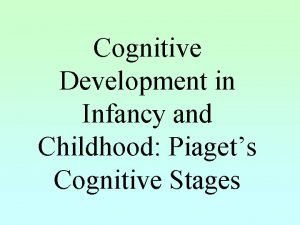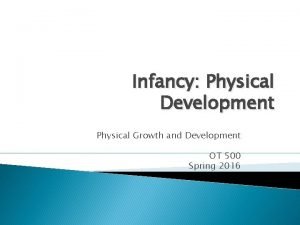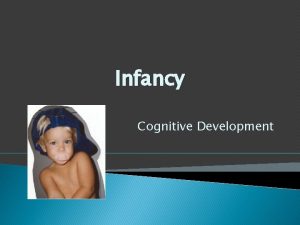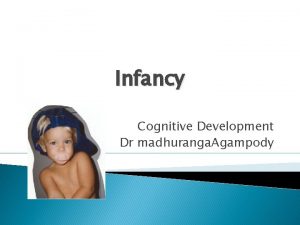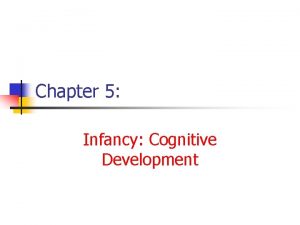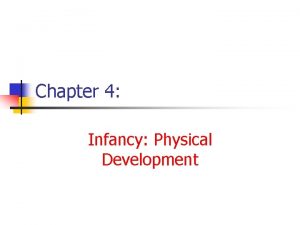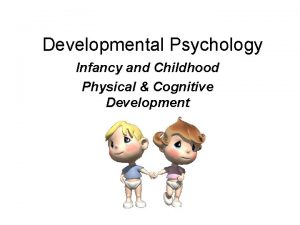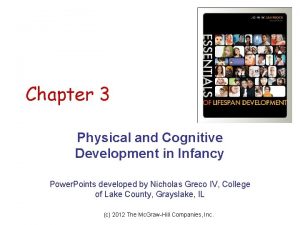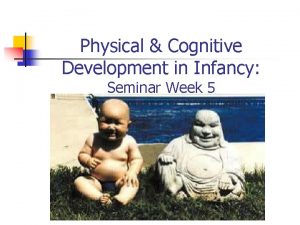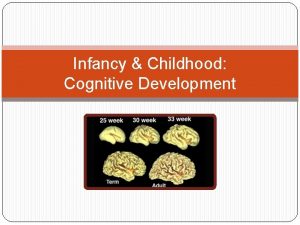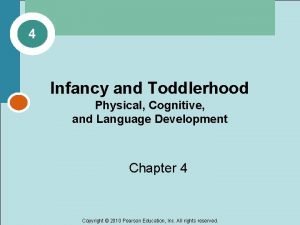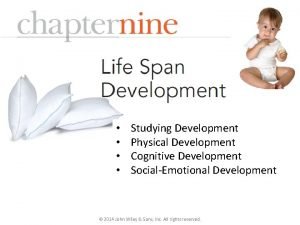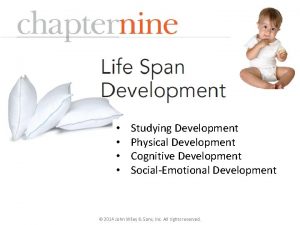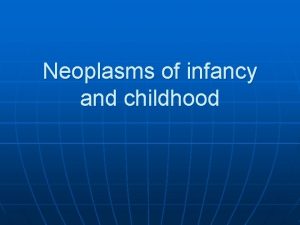Physical and Cognitive Development in Infancy CEPHALOCAUDAL AND


























































- Slides: 58

Physical and Cognitive Development in Infancy

CEPHALOCAUDAL AND PROXIMODISTAL PATTERNS Cephalocaudal -- sequence in which the earliest growth always occurs at the top, beginning with the head �physical growth and differentiation of features gradually works down from top to bottom Proximodistal -- sequence in which growth starts at the center of the body and moves toward the extremities �infants control the muscles of their trunk and arms before they control their hands

PHYSICAL GROWTH AND DEVELOPMENT IN INFANCY During the course of infancy and infant becomes capable of sitting standing stooping climbing usually walking Head large relative to the rest of the body Initially flops around uncontrollably

THE FIRST YEAR Average North American newborn - 20 inches long; 7 ½ pounds Most newborns lose 5 to 7 percent of their body weight adjusting to feeding They double their birth weight by the age of 4 months; nearly triple it by their first birthday Infants grow about 1 inch per month during the first year

FROM AGE 1 TO 2 YEARS At 2 years of age, infants weigh approximately 26 to 32 pounds �gaining a quarter to half a pound per month �attain about one-fifth of their adult weight At 2 years, the average infant is 32 to 35 inches tall �nearly half of their eventual adult height

THE BRAIN Cerebral cortex covers the forebrain like a wrinkled cap Four main areas, lobes, in each hemisphere �frontal lobes- higher thought and voluntary motor �occipital lobes –visual processing �temporal lobes - auditory processing including recognizing speech �parietal lobes – somatic sensory processing

(c) 2008 The Mc. Graw-Hill Companies, Inc.

LATERALIZATION IN THE BRAIN Two halves, or hemispheres, based on ridges and valleys in the cortex Lateralization -- specialization of function in one hemisphere or the other Even in newborns the left hemisphere is more active when processing speech sounds Left hemisphere ultimately develops to process serially and be heavily involved in language and logic Right hemisphere processes globally and is involved in spatial processing, recognizing patterns , recognizing faces

NEURON Parts of the neuron axon carries signals away from the cell body dendrites carry signals toward it myelin sheath -- a layer of fat cells -- provides insulation and helps electrical signals travel faster down the axon At the end of the axon are terminal buttons, which release chemicals called neurotransmitters into synapses Synapses -- tiny gaps between neurons' fibers


Chemical interactions in synapses connect axons and dendrites, allowing information to pass from neuron to neuron The pace of myelination also varies in different areas of the brain The infant’s brain is literally waiting for experiences to determine how connections are made (Huttenlocher & Dabholkar, 1997 and Giedd & others, 2006)

CHANGES IN BRAIN REGIONS Both heredity and environment influence synaptic overproduction and subsequent retraction “Blooming (development) and pruning” vary considerably by brain region Pruning -- unused connections are replaced by other pathways or disappear Prefrontal cortex -- the area of the brain where higher-level thinking and selfregulation occur (Johnson, 2005)

SIDS Sudden infant death syndrome (SIDS) -condition that occurs when infants stop breathing, usually during the night, and die suddenly without an apparent cause SIDS is the highest cause of infant death in the United States �Risk of SIDS is highest at 4 to 6 weeks of age (Matthews, Menacker, & Mac. Dorman, 2003)

RISK FACTORS FOR SIDS decreases when infants sleep on their backs More common in low birth weight infants Infants who are passively exposed to cigarette smoke are at higher risk More frequent in infants who sleep in soft bedding Less likely in infants who use a pacifier when they go to sleep (Tong, England, & Glantz, 2005) and (Li & others, 2006)

BENEFITS OF BREAST FEEDING Appropriate weight gain and lowered risk of childhood obesity Fewer allergies Prevention or reduction of diarrhea, respiratory infections, bacterial and urinary tract infections, and otitis media Denser bones in childhood and adulthood Reduced childhood cancer and reduced incidence of breast cancer in mothers and their female offspring Lower incidence of SIDS

(c) 2008 The Mc. Graw-Hill Companies, Inc.

WHEN MOTHER SHOULD NOT BREAST FEED If she is infected with AIDS or any other infectious disease that can be transmitted through her milk If she has active tuberculosis If she is taking any drug that may not be safe for the infant (Doherty & others, 2006)

NUTRITIONAL NEEDS Nutritionists recommend that infants consume approximately 50 calories per day for each pound they weigh This is more than twice an adult’s requirement per pound Many U. S. parents are feeding their 4 – 24 -month-old babies too few fruits and vegetables, and too much junk food

DYNAMIC SYSTEMS THEORY Multiple causes and multiple possible outcomes from any particular point Self organizing The attributes of contributing factors tend to organize in particular ways Periods of chaos or apparent randomness are part of the process of organizing Elements of previous organizational patterns become part of new patterns

DYNAMIC SYSTEMS THEORY Infants assemble motor skills for perceiving and acting, which are coupled together When infants are motivated to do something, they might create a new motor behavior Mastering a motor skill requires the infant’s active efforts to coordinate several components of the skill Supports from the surrounding environment contribute to the organization of motor skills (Adolph & Joh, 2007) (Thelen & Smith, 2006)

MASTERING A NEW SKILL The infant is motivated by a new challenge Partially accomplishes the task “Fine tunes” movements to make them smoother and more effective “Tuning” is achieved through repeated cycles of action and perception of the consequences of that action Skills result from a combination of factors including motivation, physical development, and previously learned skills

WALKING AS AN EXAMPLE Early kicking often alternates feet and provides infants practice with the alternating pattern required for stepping Development of leg strength and balance must occur before walking is possible Changes in proportion also contribute Environmental factors and supports such as parents helping by having a child walk with adult support and decreasing that support as balance improves affect development Child’s experience cruising and motivation � Child will often switch back to crawling when it is more efficient

GROSS AND FINE MOTOR SKILLS Gross Motor Skills – Skills involving coordination of the large muscles of the body Fine Motor Skills – Skills involving coordination of the smaller muscles of the extremities, especially the hands and fingers

GROSS MOTOR SKILLS Skills that involve large-muscle activities �Sitting upright without support -- 6 to 7 months of age �Crawling -- 8 ½ months �Standing -- with support at 8 months �Walking -- 12 months With experience, babies learn to avoid risky situations, integrating perceptual information with the development of a new motor behavior

(c) 2008 The Mc. Graw-Hill Companies, Inc.

GROSS MOTOR DEVELOPMENT IN THE SECOND YEAR Toddlers become more mobile 13 – 18 months can use pull a toy attached to a string their hands and legs to climb up a number of steps 18 – 24 months toddlers can walk quickly or run stiffly walk backwards without losing their balance stand kick a ball without falling and stand throw a ball jump in place

FINE MOTOR SKILLS Finely tuned movements anything that requires finger dexterity At birth, infants have very little control over fine motor skills During the first two years of life, infants refine how they reach and grasp Perceptual-motor coupling is necessary for the infant to coordinate grasping Experience plays a role in reaching and grasping

FINE MOTOR DEVELOPMENT 0 -6 MONTHS 2 Months Holds rattle briefly 2 1/2 months Glances from one object to another 3 -4 months Plays with a rattle, inspects fingers, reaches for dangling ring 4 months Carries object to mouth 4 -5 months Recovers rattle from chest, holds two objects 5 months Transfers object from hand to hand 5 -6 Bangs in play, looks for object while sitting

FINE MOTOR DEVELOPMENT 6 -12 MONTHS 6 months secures cube, retains rattle, fixates on objects and stretches to grasp them 6. 5 months Manipulates and examines objects; reaches for grabs and retains rattle 7 months Pulls string to obtain objects 7. 5 -8. 5 Grasps with thumb and finger 8 -9 months Shows hand preference 10 months Crude release of object 10. 5 - 11 Pincer grasp, pushes a car 11 -12 Puts several objects in a container

FINE MOTOR 12 -18 MONTHS Can stack blocks in imitation Scribbles with a large crayon Turns pages in a book Can make a mark with a pencil Builds a 4 block tower in imitation Can place blocks in a cup in imitation

18 -24 MONTHS Turns a doorknob using both hands Zips and unzips a large zipper after being shown Unscrews a lid after instruction Copies arcs and simple shapes drawn on a paper Connects and takes apart snap bead chains

SENSATION AND PERCEPTION Sensation occurs when information interacts with sensory receptors -- the eyes, ears, tongue, nostrils, and skin Perception is the interpretation of what is sensed Ecological View - Gibsons Our perceptual system can select from the rich information that the environment provides We directly perceive information that exists in the world around us

STUDYING THE INFANT’S PERCEPTION Perception brings us into contact with the environment in order to interact with and adapt to it Visual Preference Method -- Infants look at different things for different lengths of time Orienting response -- to determine if an infant can see or hear a stimulus Habituation -- decreased responsiveness to a stimulus after repeated presentations of the stimulus

(c) 2008 The Mc. Graw-Hill Companies, Inc.

VISUAL ACUITY AND COLOR VISION Newborn’s vision is estimated to be 20/600 on the wellknown Snellan eye examination chart By 6 months of age -- vision is 20/100 or better Young infants respond to separate parts of a pattern scanning edges and high contrast features, by 2 months can scan internal features and begin to learn to recognize patterns wholes By about the first birthday, the infant’s vision approximates that of an adult All of the eye’s color-sensitive receptors (cones) function by 2 months of age (Banks & Salapatek, 1983) (Adams, 1989)

PATTERN PERCEPTION Pattern perception Birth to 1 month 2 -3 months 4 -10 months Prefer patterns with large elements Prefer patterns with fine details Visual exploration limited to border and high contrast features Explore entire surface, including internal details Detect increasingly complex meaningful patterns Combine elements into organized whole Face perception Absence of preference for the human facial pattern Prefer faces to other equally complex patterns Recognize mom’s photo (Berk, 1999) More fine-grained discrimination Perceive emotional expressions as organized whole

PERCEPTION OF PATTERN AND DEPTH Infants prefer to look at a normal human face rather than one with scrambled features They prefer to look at a bulls-eye target or black and white stripes rather than a plain circle Prefer acuity larger bolder patterns to finer patterns due to Depth perception -- visual cliff Infants develop the ability to use binocular (two-eyed) cues to depth by about 2 to 4 months of age Monocular or pictorial cues develop around 6 -7 months

HEARING, TOUCH, AND PAIN Prenatally at 7 months, infants can hear sounds such as mother’s voice and music Immediately after birth, infants cannot hear soft sounds or pitch as well as adults do Newborns respond to touch and feel pain Infants also display amazing resiliency �Within several minutes after the circumcision surgery (which is performed without anesthesia), they can nurse and interact in a normal manner with their mothers

SMELL AND TASTE Newborns can differentiate odors Sensitivity to taste might be present even before birth At only 2 hours of age, babies made different facial expressions when they tasted sweet, sour, and bitter solutions At about 4 months of age, infants begin to prefer salty tastes, which as newborns they had found to be aversive (Windle, 1940) (Rosenstein & Oster, 1988) (Harris, Thomas, & Booth, 1990)

COGNITIVE DEVELOPMENT (c) 2008 The Mc. Graw-Hill Companies, Inc.

PIAGET’S THEORY OF COGNITIVE DEVELOPMENT Piaget thought we build mental structures that help us to adapt to the world Adaptation involves adjusting to new environmental demands Cognition is qualitatively different in one stage compared with another Sensorimotor Stage -- birth to 2 years Preoperational Stage -- 2 to 5 years

PROCESSES OF DEVELOPMENT Developing brain creates schemes, which are actions or mental representations that organize knowledge Assimilation -- children use their existing schemes to deal with new information or experiences Accommodation -- children adjust their schemes to take new information and experiences into account (Lamb, Bornstein, & Teti, 2002)

EQUILIBRIUM AND DISEQUILIBRIUM Cognitive conflict -- disequilibrium the child is constantly faced with inconsistencies and counterexamples to existing schemes An internal search for equilibrium creates motivation for change the child assimilates and accommodates, develops new schemes, and organizes and reorganizes old and new schemes Equilibration -- mechanism by which children shift from one stage of thought to the next Organization – schemes are organized and linked

OBJECT PERMANENCE Object permanence -- understanding that objects continue to exist even when they cannot be seen, heard, or touched One of the infant’s most important accomplishments Watch an infant’s reaction when an interesting object disappears. If the infant searches for the object, it is inferred that the baby knows it continues to exist A not B search error Infants will look in a place they have previously found an object rather than the place they saw it hidden

SENSORIMOTOR STAGE Infants construct an understanding of the world by coordinating sensory experiences (such as seeing and hearing) with physical actions Circular reaction – an event that first occurs by chance is intentionally repeated and practiced until it becomes a new scheme

SENSORIMOTOR SUBSTAGES Initially unintentional and focused on their own bodies Substage 1 - (birth to 1 month)reflexive schemes Piaget viewed reflexes as the building blocks for sensorimotor intelligence Infant behavior is guided by reflexes and instinct Substage 2 – (1 -4 months) primary circular reactions Repetition of chance behaviors that lead to satisfying results Behavior varies based on environmental demands Shape actions to get desired results Begin to anticipate events

SENSORIMOTOR SUBSTAGES 2 Infants begin to be oriented to objects and develop schemes regarding objects Substage 3 - Secondary circular reactions – (4 -8 months) making interesting sights last Repeats an initially accidental action such as hitting an object to make it move Can apply them to other objects Substage 4 -Coordination of secondary circular reactions (8 -12 months) Combines secondary circular reactions into more complex schemes Can organize and combine schemes to solve problems First evidence of goal directed behavior and problem solving

SENSORIMOTOR SUBSTAGES 3 Focus on objects and others –highly intentional and have achieved object permanence Substage 5 - Tertiary circular reactions (12 -18 months) New means through active exploration Repeat behaviors with variation Actively experiment to find out what happens under different conditions Substage 6 – mental representation (18 -24 months) inventing new means through mental combination Can finally create and manipulate mental representations of objects Capacity for deferred imitation

EVALUATION OF THE SENSORIMOTOR STAGE Develop when • Object search • A-not-B Piaget • Make-believe play suggested • Object permanence Develop earlier • Deferred imitation than Piaget • Categorization suggested • Problem solving by analogy Some suggest infants are born with core knowledge in several domains of thought Copyright © Allyn & Bacon 2007

VIOLATION OF EXPECTATIONS METHOD Cop yrig ht © Allyn & Bac on 2007

DEFERRED IMITATION Piaget: Develops about 18 months Newer research: 6 weeks – facial imitation § 6 – 9 months – copy actions with objects § 12 – 14 months – imitate rationally § 18 months – imitate intended, but not completed, actions § Copyright © Allyn & Bacon 2007

THREE THEORIES OF LANGUAGE DEVELOPMENT Learned through Behaviorist • Operant conditioning (reinforcement) • Imitation Nativist Inborn Language Acquisition Device (LAD) biologically prepares infants to learn rules of language • Inner capacities and environment work Interactionist together • Social context is important Copyright © Allyn & Bacon 2007

NOAM CHOMSKY AND OTHERS LAD -- Humans are biologically prewired to learn language at a certain time and in a certain way and to detect the various features and rules of language Behaviorists opposed Chomsky's LAD hypothesis Language is not learned in a social vacuum Michael Tomasello’s interaction view of language emphasizes that children learn language in specific contexts (Tomasello, 2003, 2006)

LANGUAGE DEVELOPMENT Language -- a form of communication —whether spoken, written, or signed— that is based on a system of symbols All human languages have some common characteristics �Rules describe the way the language works �Infinite generativity -- the ability to produce an endless number of meaningful sentences using a finite set of words and rules (Berko Gleason, 2004)

KEY MILESTONES IN LANGUAGE DEVELOPMENT Babies' sounds and gestures go through this sequence during the first year �Crying: can signal distress, but there are different types of cries that signal different things �Cooing: about 1 to 2 months, gurgling sounds that are made in the back of the throat and usually express pleasure during interaction with the caregiver �Babbling: In the middle of the first year, babies babble -strings of consonant-vowel combinations, such as “ba, ba, ba” �Gestures: Infants start using gestures, such as showing and pointing, at about 8 to 12 months of age � Joint attention: Sharing an experience following others’ cue or initiating focus on the same object or activity

LANGUAGE Phonemes -- the basic sound units of a language First words (usually nouns) occur between 10 to 15 months Overextension -- the tendency to apply a word to objects that are inappropriate for the word’s meaning Underextension -- the tendency to apply a word too narrowly Telegraphic Speech– short utterances without use of articles, connectors, auxiliary verbs and other grammatical markers Two word utterances want cookie (Menyuk, Liebergott, & Schultz, 1995)


HELPING PARENTS FACILITATE LANGUAGE DEVELOPMENT Be an active conversational partner Talk as if the infant understands what you are saying Remember to listen to toddlers Pay attention to gestures Use a language style with which you are comfortable, but consider ways of expanding your child’s language abilities and horizons Adjust to your child’s idiosyncrasies instead of working against them Growing Up with Language by Naomi Baron (1992)
 Ap psych schema
Ap psych schema Module 47 infancy and childhood cognitive development
Module 47 infancy and childhood cognitive development Chapter 5 cognitive development in infancy and toddlerhood
Chapter 5 cognitive development in infancy and toddlerhood Infancy and childhood physical development
Infancy and childhood physical development Module 46 infancy and childhood physical development
Module 46 infancy and childhood physical development Cephalocaudal development
Cephalocaudal development Proximodistal development
Proximodistal development Psych pool uwindsor
Psych pool uwindsor Social development in infancy and childhood
Social development in infancy and childhood Emotional development is often stormy and in conflict
Emotional development is often stormy and in conflict Definition of intellectual in health and social care
Definition of intellectual in health and social care Infancy physical changes
Infancy physical changes Cognitive development early adulthood
Cognitive development early adulthood Cognitive development during early adulthood
Cognitive development during early adulthood Define physical cognitive and psychosocial development
Define physical cognitive and psychosocial development Socioemotional development in infancy
Socioemotional development in infancy Infancy psychosocial development
Infancy psychosocial development Stage of growth and development
Stage of growth and development Personality development in infancy
Personality development in infancy Personality development in infancy
Personality development in infancy Emotional development in infancy
Emotional development in infancy Cognitive and non cognitive religious language
Cognitive and non cognitive religious language Cephalocaudal and proximodistal pattern diagram
Cephalocaudal and proximodistal pattern diagram Contoh prinsip cephalocaudal
Contoh prinsip cephalocaudal Proximodistal adalah
Proximodistal adalah Cephalocaudal
Cephalocaudal Cephalocaudal growth
Cephalocaudal growth Cephalocaudal pattern
Cephalocaudal pattern Cephalocaudal adalah
Cephalocaudal adalah Cephalocaudal definition
Cephalocaudal definition Cephalocaudal gradient of growth
Cephalocaudal gradient of growth Infancy and childhood psychology
Infancy and childhood psychology Psychology chapter 10 infancy and childhood
Psychology chapter 10 infancy and childhood Chapter 10 infancy and childhood
Chapter 10 infancy and childhood Psychology chapter 10 infancy and childhood
Psychology chapter 10 infancy and childhood Lesson quiz 3-2 infancy and childhood
Lesson quiz 3-2 infancy and childhood Denny's model of physical and cognitive ageing
Denny's model of physical and cognitive ageing Denny's model of physical and cognitive ageing
Denny's model of physical and cognitive ageing Infancy period
Infancy period Proximodistal development
Proximodistal development Infancy
Infancy Catastrophic epilepsy infancy
Catastrophic epilepsy infancy The cases of anna, isabelle, and genie
The cases of anna, isabelle, and genie Infancy childhood adolescence adulthood old age
Infancy childhood adolescence adulthood old age Pies in infancy
Pies in infancy Pavlik harness
Pavlik harness For adult
For adult Messianic prophecies fulfilled in the infancy narratives
Messianic prophecies fulfilled in the infancy narratives Physical development of late childhood
Physical development of late childhood Education cognitive development
Education cognitive development The investment of an employee's physical cognitive
The investment of an employee's physical cognitive Intellectual development middle adulthood
Intellectual development middle adulthood Intellectual development in older adulthood
Intellectual development in older adulthood Gerome bruner
Gerome bruner Information processing theory summary
Information processing theory summary Emerging adulthood cognitive development
Emerging adulthood cognitive development Ib psychology cognitive level of analysis
Ib psychology cognitive level of analysis Cognitive development characteristics
Cognitive development characteristics Piaget information processing theory
Piaget information processing theory



